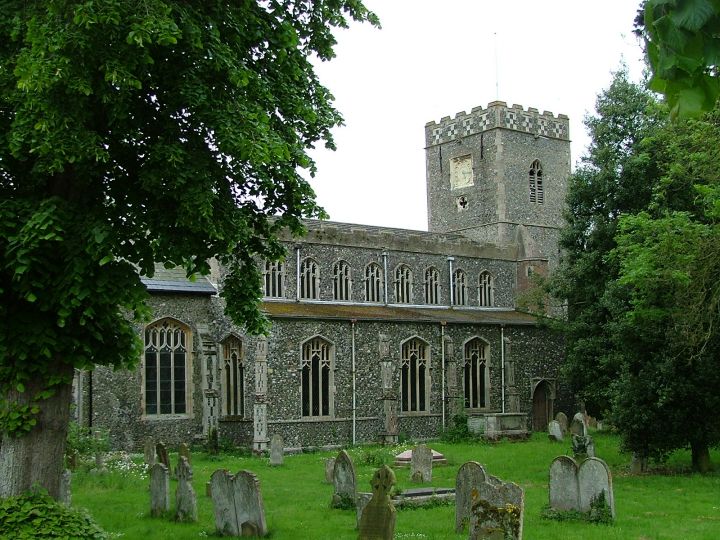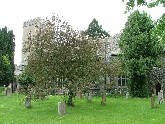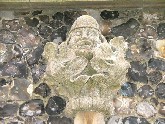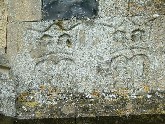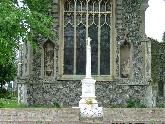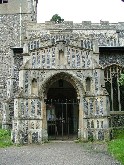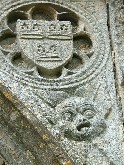| |
|
All
Saints, Dickleburgh
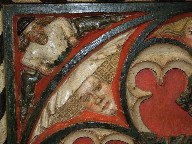 |
|
2010 will remain memorable
for a number of reasons, one of them being that
it was the year in which, at last, I got to see
inside Dickleburgh church, at the sixth attempt.
Back in 2006 I had moaned heartily on this site
about arriving here on my bike in driving rain hoping to
shelter from in the church, or at least in the
porch in the traditional manner - one of the
functions of such structures was to provide
shelter for pilgrims and travellers. But it was
not to be. As the heavens emptied on me, I was
reduced to rattling the outer doors of the porch
in frustration, for I was kept out by a fearsome
padlock. There was no notice to tell me where
the key was - indeed, it wasn't actually possible
to read any of the notices, because they were all
locked up inside the porch. When I said as much
on this site, a kind and gentle lay reader
contacted me to tell me that Dickleburgh church
is, in fact, open all day and every day, and I
must simply have arrived too late in the day to
find it open.
|
Be that as
it may, my visits over the next few years, at differing
times of the day and in various months of the year, found
exactly the same situation, so when Peter and I learned
that Dickleburgh church was taking part in the Norfolk
Open Churches week in 2010, we headed on the first
morning at a reasonably good speed up the A12 to check it
out. You'll not be surprised to learn that we arrived to
find the church locked.
It must be
said that Peter partly blamed me. He had a point - he had
seen inside already, because on one occasion he had found
the church open, but every time he had come this way with
me it had been locked, just as when I had attempted to
see inside on my own. However, leaving Dickleburgh by a
different route we found a roadside notice advertising a
flower festival, due to begin that afternoon. So, after a
few hours we headed back, and not even fate or
circumstance could this time prevent us from finding the
porch gates open.
I'm not a
huge fan of flower festivals, but it is a useful way of
seeing inside more reclusive churches, and in any case
All Saints is such a vast barn of a building it would be
difficult for the arrangements to be a distraction.
Although considerably restored and renewed, the building
is essentially a typical 15th Century great East Anglian
church, with an earlier tower as is often the case. The
porch, which I had got to know rather well, is
spectacular, the very apotheosis of devotional
craftsmanship on the eve of the Reformation. If the tower
had been rebuilt it would no doubt have been much higher.
The kind
man on duty gave us a leaflet and told us which was the
best way to go round to see the flowers. It seemed
churlish to say that we'd actually come to see the church
rather than the flowers, especially as we were planning
to take photographs. As we wandered up the aisle he
pressed a cassette into the deck on the PA system behind
him, and soon the building was filled with the rather
unedifying sound of what appeared to be the London
Symphony Orchestra's version of A Whiter Shade of
Pale, probably from an album called something like Rock
Goes Classical: the LSO Play the Hits, or something.
I sighed, and decided that I would have to accept that my
visit to Dickleburgh church was not going to be like my
other visits elsewhere - which, as it turned out, was
quite all right, because Dickleburgh church is not like
other churches.
The most
famous feature is probably the screen, of which only the
dado survives, but it is intricately and beautifully
carved, and, as Pevsner observed, very unusual. Restored
sympathetically in red, green and cream, it features in
its spandrels a cavalcade of mysterious beasts and
people, of which the monk playing pipes and the dog
catching a rabbit are among the most striking.
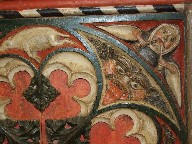 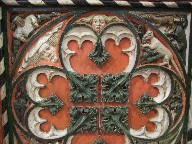 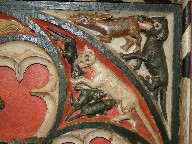 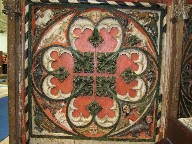
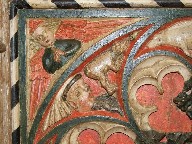 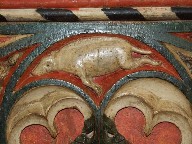 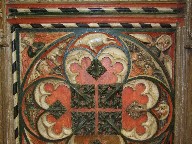 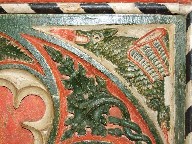
Turning
back west, the early 19th Century gallery survived the
Victorians, possibly because it was still so new. On the
front of it there is a good set of royal arms for Charles
II dated 1662, although Mortlock thought they might be a
repainted earlier Stuart set from before the
Commonwealth. It is interesting to see a set so soon
after the Restoration of the Monarchy. Dickleburgh was
plainly a solidly royalist parish, as can be seen from
two splendid memorials up in the chancel, one to Dame
Frances Playters, who died on the eve of the Restoration
in 1659, and the other to Christopher Barnard, the
Caroline Rector of this place. Dame Frances has one of
the most memorable memorials in Norfolk - she is shown
standing in her graveclothes looking out over the chancel
for all the world as if she is surveying it from a
window, or more precisely an opera box. The inscription
below it notes that her husband William Players, deputy
lieutenant and Vice Admiral of Suffolk, a Justice of the
Peace and Colonel of the Regiment of Foot, was turned
out of all by the then rebellious Parliam't and... out of
the Hous of Parliam't whereof he had ye misfortune to be
a member.
Barnard's
inscription records an even more extraordinary story,
telling that, after he was arrested by the Puritans,
his parishioners... thought it a judgement upon them when
ye soudyers drag'd him away to carry him to Norwich
Castle; but his beloved flock follow'd him and resqued
him and hid him a long time after. it is said that
they hid his corn and threshed it secretly. You'll be
pleased to know that Barnard survived the long
Cromwellian night, and lived to see the Restoration. The
puritan arrogance and stupidity against which the good
parishioners of Dickleburgh positioned themselves has a
much quieter presence here, its only relic being a most
unusual ledger stone of the 1650s, which is scratched
poorly with an image of a lady of substance. It is a
gentle reminder of the glorification of ignorance which I
am afraid has continued to run as a minor yet
occasionally visible thread through certain sections of
English culture ever since.
| The
east window is by Hardman & Co, more usually
employed by Catholic churches, and inevitably the
work seems somewhat out of place in what is now a
thorough-going evangelical worship space.
Unfortunately, all the internal lighting was on
full, which made taking photographs of the glass
rather difficult, especially as the great east
window is most unfortunately covered with
perspex, presumably to help keep the heat in. To the
strains of the LSO struggling manfully with You
Sexy Thing or somesuch, we thanked our kind
hosts and headed out in to the churchyard. To the
west of the church is the fine school built in
1812 and extended in 1842 for the Parish, an
unusual survival. To the north of it are a number
of most interesting headstones, perhaps the most
memorable of which is to Basil Charles Lines, a
private in the 4th battalion of the Norfolk
Regiment. The deep cut relief at the top of the
headstone depicts an enlaurelled rifle and cap,
bearing the Norfolk Regiments badge. Basil Lines
lied about his age to enlist, but died of
pneumonia before he could be sent abroad. He was
just 17 years old.
|
|
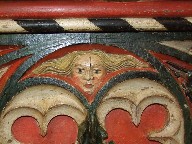 |
Simon Knott, February 2011
|
|
|

